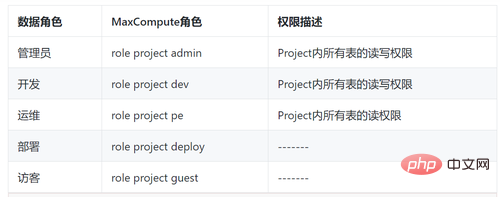 Operation and Maintenance
Operation and Maintenance
 Safety
Safety
 What is the overall architecture of MaxCompute access control?
What is the overall architecture of MaxCompute access control?
What is the overall architecture of MaxCompute access control?
Basic terminology
project: Project space, the basic unit that MaxCompute provides users with self-service management.
Access control: Check whether a request is credible and legal.
ACL: Access control list, an expression of authorization.
Policy: A rule-based authorization expression.
Role: A collection of permissions, used to implement role-based permission management.
LabelSecurity: Label-based access control, used to implement column-level permission management.
ProjectProtection: Project space protection, used to enable data flow access control.
TruestedProject: Trusted project space, used for access control authorization of project space data flow.
ExceptionPolicy: A description of exceptions to the project space protection mechanism, project space data flow to access control authorization.
Package: A medium for resource sharing between project spaces.
Overall architecture of MaxCompute access control

Identity authentication: access MaxCompute first Identity authentication is required.
Request source check (IP whitelist): Check the IP that submitted the access request and ensure that the IP is in the IP whitelist before you can access MaxCompute.
Project space status check: often used for operations or maintenance. If MaxCompute is in arrears and the project is frozen, no requests can be passed to MaxCompute at this time.
LabelSecurity check: Access control of column-level sensitive data.
Role/Policy/ACL: Finally, check the permissions of the role, as well as the Policy and ACL permissions.
DataWorks permission management and MaxCompute permission management

The above is the detailed content of What is the overall architecture of MaxCompute access control?. For more information, please follow other related articles on the PHP Chinese website!

Hot AI Tools

Undresser.AI Undress
AI-powered app for creating realistic nude photos

AI Clothes Remover
Online AI tool for removing clothes from photos.

Undress AI Tool
Undress images for free

Clothoff.io
AI clothes remover

Video Face Swap
Swap faces in any video effortlessly with our completely free AI face swap tool!

Hot Article

Hot Tools

Notepad++7.3.1
Easy-to-use and free code editor

SublimeText3 Chinese version
Chinese version, very easy to use

Zend Studio 13.0.1
Powerful PHP integrated development environment

Dreamweaver CS6
Visual web development tools

SublimeText3 Mac version
God-level code editing software (SublimeText3)

Hot Topics
 1386
1386
 52
52

